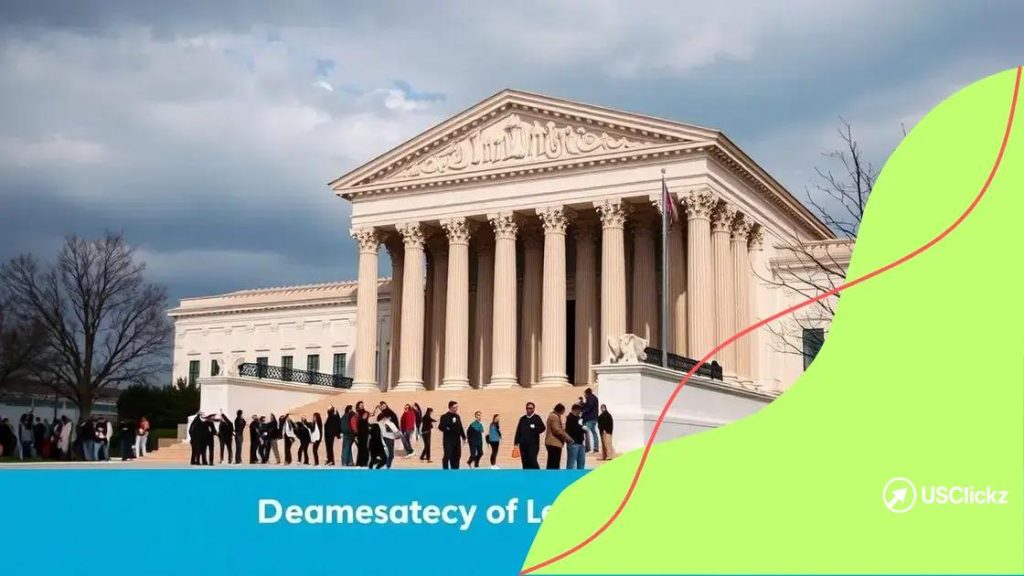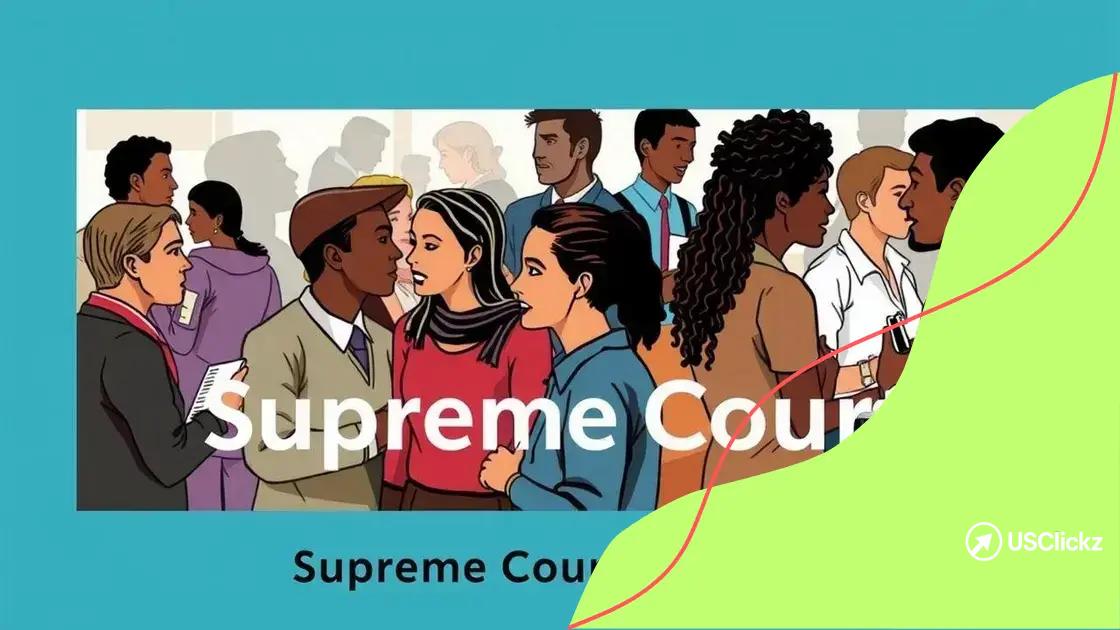Supreme Court: Key decisions that shaped America

Anúncios
The Supreme Court plays a vital role in shaping American society by interpreting laws and addressing key issues such as civil rights, technology regulation, and public opinion impacts on legal decisions.
Supreme Court: Key decisions have profoundly shaped the legal landscape of the United States. Have you ever wondered how much these rulings impact your daily life? Let’s delve into some landmark cases.
Major Supreme Court cases in history
Understanding the major Supreme Court cases in history helps us grasp how the legal system evolves over time. These cases represent pivotal moments that have reshaped society and defined rights.
Brown v. Board of Education
This landmark case in 1954 declared state laws establishing separate public schools for black and white students unconstitutional. It was a key moment in the civil rights movement, demonstrating that segregation in education was inherently unequal.
Roe v. Wade
Decided in 1973, this case recognized a woman’s legal right to an abortion under the Constitution. It sparked extensive debate and mobilization on both sides of the issue, influencing countless legal and social discussions.
- Significant societal implications arose from the ruling.
- The case set a precedent for privacy rights.
- Public opinion remains divided on this subject.
Miranda v. Arizona
This 1966 case led to the establishment of the Miranda rights, requiring police to inform suspects of their rights during an arrest. This case underscored the importance of protecting individuals from self-incrimination.
These cases show how the Supreme Court not only interprets the law but also shapes our society. Each decision reflects changing moral and social ideals, influencing daily life.
Impact of Supreme Court decisions on civil rights
The impact of Supreme Court decisions on civil rights cannot be overstated. These rulings have changed the landscape of American society and influenced millions of lives. Through their interpretations of the Constitution, the Court has shaped a more equitable world.
The Civil Rights Movement
During the 1960s, many landmark Supreme Court cases emerged as pivotal moments in the civil rights movement. Decisions like Brown v. Board of Education were instrumental in ending segregation in schools, marking a significant advance for equality.
- Brown v. Board established that separate educational facilities are inherently unequal.
- This decision galvanized further action and legislation for civil rights.
- It served as a foundation for future cases regarding discrimination.
Voting Rights
The Supreme Court has also played a significant role in protecting voting rights. For example, in the case of Voting Rights Act of 1965, the Court upheld measures to combat racial discrimination in voting, ensuring that all Americans could exercise their right to vote.
Throughout history, the Court’s decisions reflect a deeper understanding of justice and equality. Each ruling adds to the evolution of civil rights, allowing marginalized voices to resonate within the legal framework.
These significant rulings demonstrate the power of the Supreme Court in promoting and protecting civil rights for individuals across the nation. The effects of these cases ripple through time, highlighting the ongoing need for vigilance in safeguarding liberty and justice for all.
How Supreme Court rulings affect everyday life

Supreme Court rulings have a direct impact on everyday life in the United States. These decisions shape laws, influence rights, and affect how individuals interact with governmental entities. Understanding this impact helps us recognize the importance of the Court in our lives.
Rights and Freedoms
Many rulings set precedents that protect personal freedoms. For example, the decision in Obergefell v. Hodges legalized same-sex marriage, fundamentally changing how couples can express their love and commitment. This case illustrates how a ruling directly influences people’s lives.
Workplace Regulations
The Supreme Court also plays a crucial role in workplace policies. In the case of Epstein v. Washington State Department of Transportation, the Court ruled on workplace discrimination, allowing individuals to seek justice if they experience unfair treatment based on gender or race. Such rulings are vital for creating fair work environments.
- Employment protections help workers feel secure and valued.
- These decisions encourage businesses to promote equality.
- They set standards that guide employee rights.
Additionally, rulings affect how laws are enforced. When the Court decides in cases involving law enforcement, such as Ferguson v. City of Charleston, it addresses privacy rights and limits police powers. These decisions ensure individuals are protected from unlawful searches and seizures, reaffirming essential civil liberties in daily interactions with law enforcement.
Ultimately, the influence of the Supreme Court extends beyond the courtroom. It touches every aspect of life, from education to the workplace to personal relationships. As these rulings evolve, they continue to shape a society that strives for fairness and justice.
The role of public opinion in Supreme Court decisions
The role of public opinion in Supreme Court decisions is significant and complex. While the Court is meant to be an impartial body that interprets the law, it does not operate in a vacuum. Public sentiment can often influence its rulings and the justices’ considerations.
The Influence of Public Sentiment
Supreme Court justices are aware of the cultural and social climate surrounding the cases they decide. For instance, during the civil rights era, public opinion shifted dramatically. As people rallied for equality, the justices faced mounting pressure to reconsider longstanding laws.
Key Cases Reflecting Public Opinion
One notable example is the case of Obergefell v. Hodges, which legalized same-sex marriage in 2015. As public support for LGBTQ+ rights grew, the Court’s decision mirrored this shift in public sentiment. This ruling demonstrates how the justices respond to changing attitudes.
- Public opinion can prompt the Court to reevaluate outdated laws.
- High-profile cases often attract widespread media attention, shaping public views.
- Judges consider societal values, especially in landmark decisions.
Furthermore, the Court has occasionally taken cues from national discussions. Issues like healthcare, immigration, and reproductive rights often reflect broader societal debates. The justices may feel the weight of these discussions as they deliberate on pivotal cases.
In conclusion, while the Supreme Court operates independently, its decisions are often intertwined with public opinion. This relationship shapes the legal landscape and reflects the evolving values of society, ensuring that the law stays relevant in a changing world.
Future challenges for the Supreme Court
The future challenges for the Supreme Court will be significant as societal norms and legal standards evolve. As new issues emerge, the Court will need to address complex matters that will influence the nation’s legal framework.
Technological Advancements
One of the primary challenges will involve the regulation of technology. Issues such as data privacy, surveillance, and the impact of social media on free speech will require careful consideration. As technology continues to advance, the justices will face tough questions about how to protect individual rights while balancing national security.
Social Justice and Equality
Additionally, the Court will encounter ongoing debates around civil rights. Cases involving discrimination based on gender identity, race, and disability will likely come before the Court frequently. These rulings can shape the trajectory of social justice movements in the United States.
- Ensuring equitable access to resources and opportunities.
- Addressing the balance between religious freedoms and anti-discrimination laws.
- Safeguarding the rights of marginalized communities.
The impact of climate change is another emerging issue. Environmental laws and regulations may lead to new legal battles, as individuals and states seek to hold corporations accountable for their environmental practices. The Court will need to define the legal responsibilities of these entities in a changing climate.
Health care policies will also present challenges, particularly as discussions about universal health care and reproductive rights evolve. The Court’s decisions in these areas will have lasting effects on American families and their access to essential services.
FAQ – Frequently Asked Questions about the Supreme Court and Its Impact
How does the Supreme Court affect everyday life?
The Supreme Court’s decisions shape laws and protect rights, impacting various aspects of daily life such as education, healthcare, and employment.
What are some future challenges the Supreme Court will face?
The Court will confront challenges related to technology regulation, social justice issues, and healthcare policies in the coming years.
How does public opinion influence Supreme Court decisions?
Public opinion can shift over time, prompting the Court to reconsider laws and rulings to align with changing societal values.
Why is it important to understand the role of the Supreme Court?
Understanding the Court’s role helps citizens appreciate its influence on democracy and the protection of individual rights.